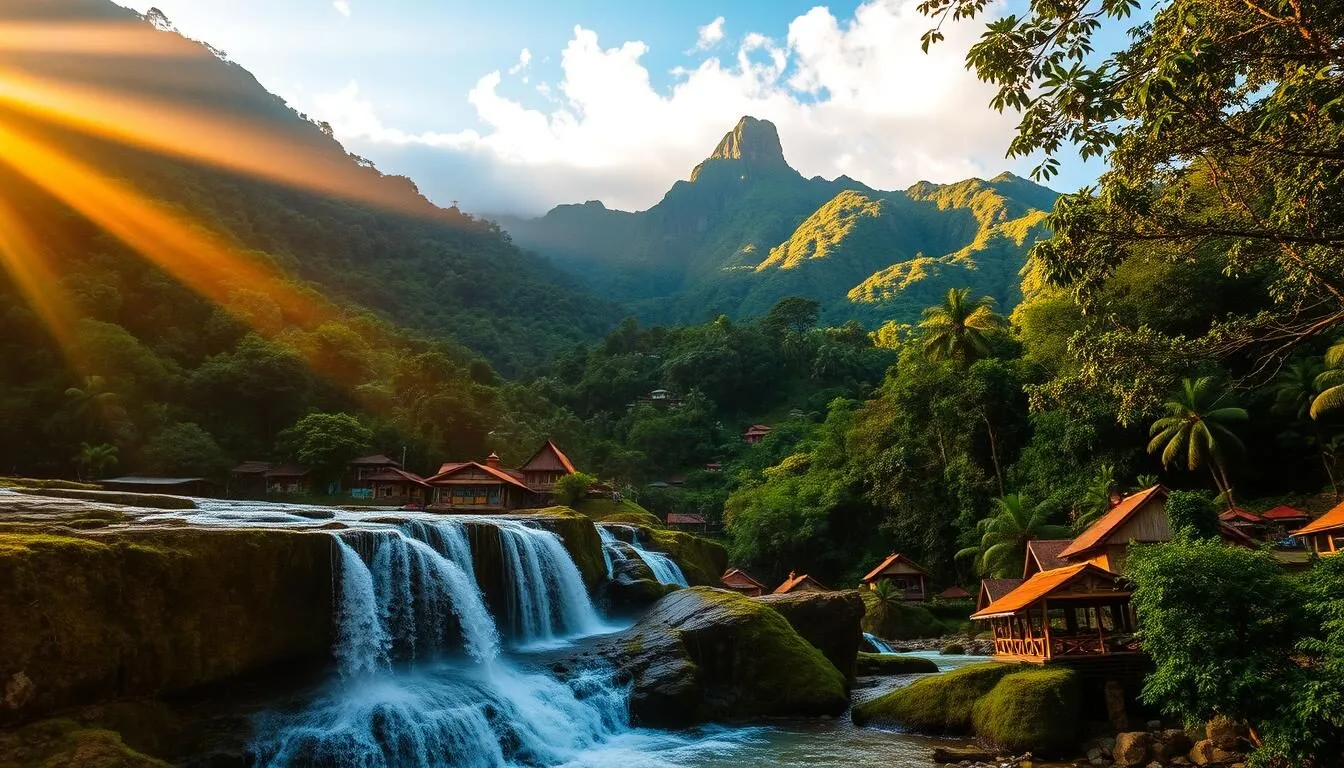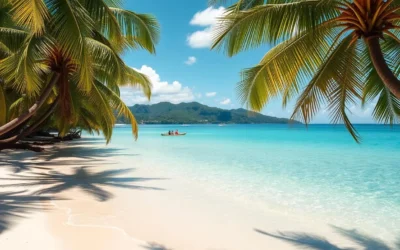Imagine yourself surrounded by pristine beaches and crystal-clear water, or trekking through lush landscapes to breathtaking attractions. Mindanao, the second-largest island in the Philippines, offers an incredible array of experiences. You can enjoy world-class surfing in Siargao or explore the rich cultural heritage of the region.
As you explore this captivating region, you’ll discover a melting pot of traditions and dances, from the T’boli beadwork to Maranao celebrations. With its diverse ethnic groups and natural beauty, Mindanao provides an authentic and unforgettable experience. Get ready to uncover the top attractions and activities that make this southern Philippine gem a must-visit destination.
Discovering Mindanao: The Philippines’ Southern Gem
Mindanao, often overlooked by travelers, is a hidden gem that promises unforgettable experiences amidst its stunning natural beauty and diverse cultural influences. As you explore this southernmost major island of the Philippines, you’ll discover a treasure trove of natural wonders, vibrant cultures, and warm people.
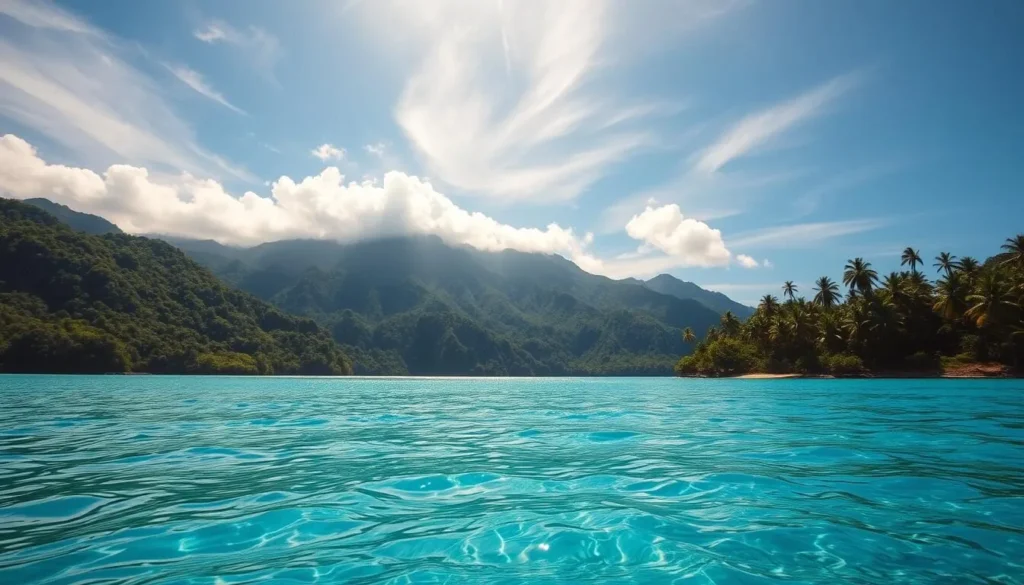
Geography and Location of Mindanao
Mindanao is the second-largest island in the Philippines, covering over 97,000 square kilometers and making up about a third of the country’s total land area. The island boasts diverse geography, including the country’s highest peak, Mount Apo, vast plains, numerous rivers, lakes, and coastlines dotted with beautiful beaches and marine sanctuaries. This varied landscape not only provides breathtaking nature but also offers a range of outdoor activities and adventures.
- Vast mountain ranges and peaks, including Mount Apo, the highest point in the Philippines.
- Extensive coastlines with pristine beaches and marine sanctuaries.
- Vast plains and numerous rivers, supporting agriculture and offering scenic views.
Cultural Diversity and Heritage
Mindanao is home to a rich tapestry of cultures, with over 13 ethnolinguistic groups, including the Tausug, Maranao, T’boli, and Bagobo. Each of these groups has its own distinct traditions, arts, and cuisines, contributing to the island‘s unique cultural landscape. The region offers a fascinating blend of indigenous, Islamic, and Christian influences that have shaped its heritage over centuries. Visitors can experience this cultural diversity firsthand by interacting with the local people and participating in cultural events.
The cultural heritage of Mindanao is reflected in its vibrant festivals, traditional crafts, and local cuisine. From the intricate designs of the T’boli to the majestic dances of the Maranao, the cultural richness of Mindanao is a treasure waiting to be explored.
Why Mindanao Should Be on Your Travel Radar
Despite misconceptions about safety, many parts of Mindanao are peaceful and welcoming to tourists. Davao City, for instance, is frequently ranked among the safest cities in Southeast Asia. The island remains less commercialized than popular destinations like Boracay or Palawan, offering authentic experiences and interactions with local people. Mindanao’s natural attractions rival any in the Philippines, and visitors can enjoy them without the crowds found at more established tourist destinations.
Whether you’re drawn to the great outdoors, cultural experiences, or simply looking for a new adventure, Mindanao has something to offer. Its unique blend of natural beauty, cultural diversity, and warm hospitality makes it an ideal destination for travelers looking to explore beyond the usual tourist spots.
Best Time to Visit Mindanao Island
Whether you’re looking for beach activities, cultural immersion, or adventure, understanding the best time to visit Mindanao Island is key to a successful trip. The island’s diverse geography and climate mean that the optimal time for your visit depends on what you want to experience.
Seasonal Weather Patterns
Mindanao Island experiences a tropical climate, with the dry season typically running from November to April. During this time, the weather is generally predictable, and outdoor activities are more enjoyable due to minimal rainfall and comfortable temperatures averaging between 75-85°F (24-29°C). The dry season is considered the best time for a trip to Mindanao, as it allows for a wide range of activities without the hindrance of wet weather.
As the dry season progresses into March to May, temperatures rise, making it an ideal period for beach activities and water sports, particularly in destinations like Siargao and Samal Island. However, it’s worth noting that the wet season, from June to October, brings increased rainfall and the potential for typhoons, especially affecting the eastern coastal areas. Western Mindanao tends to receive less precipitation during this time.
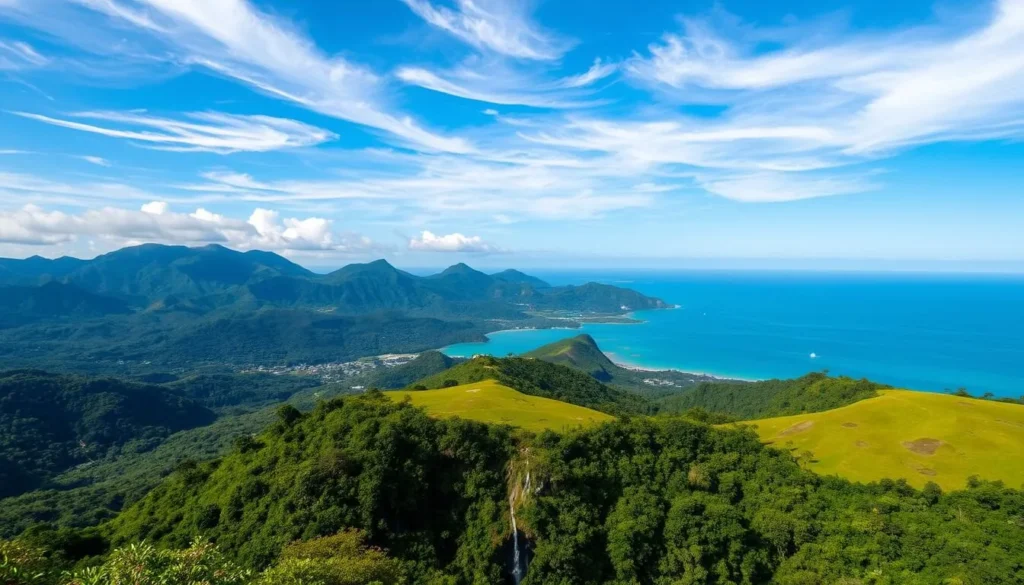
Festival Calendar and Cultural Events
Mindanao is not just about natural beauty; it’s also rich in cultural heritage, celebrated through various festivals throughout the year. Timing your trip around these events can add a unique dimension to your experience. For instance, Davao’s Kadayawan Festival in August is a highlight, showcasing the region’s culture, food, and flowers. Similarly, Cagayan de Oro’s Higalaay Festival and General Santos City’s Tuna Festival in September are significant cultural events that offer insights into the local way of life.
These festivals are not just entertaining; they provide a chance to engage with the local community and understand the island’s traditions. If you’re interested in cultural immersion, planning your trip around these festivals can be a great way to experience the authentic spirit of Mindanao.
Peak vs. Off-Peak Travel Considerations
While the dry season is considered peak travel time, there are advantages to visiting during the shoulder seasons (May-June or October-November). Off-peak travel can offer significant savings on accommodations and less crowded attractions, with the added benefit of still having some good weather days. Surfers, in particular, should plan their trip to Siargao between August and November to catch the optimal swells at Cloud9, coinciding with international surfing competitions.
It’s also important to research specific regional conditions for your intended destinations, as day-to-day weather can vary significantly across Mindanao’s diverse geography. By considering these factors, you can plan a trip that balances your preferences for weather, activities, and cultural experiences, ensuring a memorable time on the island.
Siargao Island: Surfing Paradise and Natural Wonders
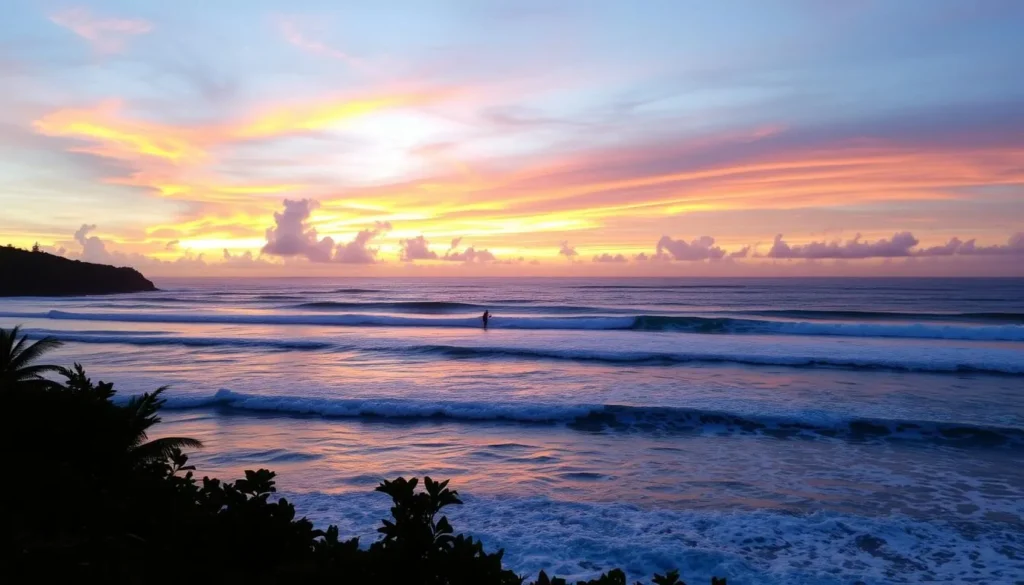
As the Philippines’ premier surfing destination, Siargao Island attracts surfers from around the globe with its consistent waves and laid-back atmosphere. This teardrop-shaped island has gained international recognition, rivalling top surfing spots in Indonesia and Australia.
Cloud9: World-Class Surfing Experience
Cloud9 in General Luna is Siargao’s most famous surfing spot, hosting the annual International Surfing Cup. The reef break produces powerful waves, making it a favourite among professional surfers. Whether you’re a seasoned surfer or a beginner, Cloud9 offers an exhilarating experience.
The waves at Cloud9 are consistent throughout the year, but the peak season is from September to November. During this time, the waves are at their best, attracting surfers from all over the world.
Island Hopping to Daku, Guyam, and Naked Island
Siargao island-hopping tours are a must-try, offering visits to pristine white sand beaches on Daku Island, the tiny Guyam Island, and the stunning sandbar of Naked Island. These tours allow you to experience the beauty of Siargao’s surrounding islands.
Daku Island, the largest of the trio, boasts a beautiful beach and crystal-clear waters perfect for swimming and snorkelling. Guyam Island, on the other hand, is a tiny island with a picturesque beach, ideal for relaxation. Naked Island, with its stunning sandbar, is perfect for sunbathing and swimming.
Sugba Lagoon and Magpupungko Rock Pools
The emerald waters of Sugba Lagoon provide an idyllic setting for paddleboarding, cliff jumping, and swimming in a tranquil environment surrounded by limestone cliffs and lush mangroves. You can also explore the lagoon’s depths with a guided snorkelling or diving tour.
Magpupungko Rock Pools, another natural wonder, offer a unique phenomenon where tidal pools form during low tide, creating natural swimming pools with crystal-clear water perfect for snorkelling and cliff jumping.
Where to Stay in Siargao
Most accommodations in Siargao cluster around General Luna, ranging from budget hostels to luxury resorts, many offering direct beach access and surfboard rentals. You can choose a resort that suits your budget and preferences, ensuring a comfortable stay while enjoying the island’s activities.
Davao City: Urban Adventures and Natural Attractions
As the main gateway to Mindanao, Davao City offers a blend of urban excitement and natural beauty. With its international airport and reputation as one of the safest cities in the Philippines, it’s an ideal base for travelers.
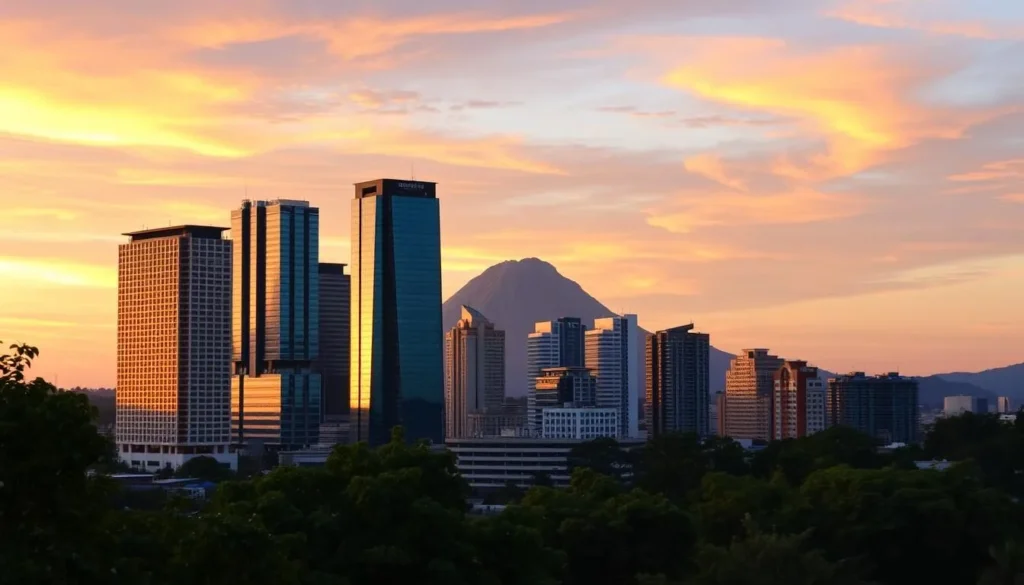
Meeting the National Bird at the Philippine Eagle Center
The Philippine Eagle Center is a must-visit attraction in Davao City, providing a unique opportunity to see the critically endangered Philippine Eagle up close. With conservation efforts in place, visitors can learn about the protection of this majestic national bird.
Eden Nature Park: A Mountain Resort Experience
Eden Nature Park, situated 3,000 feet above sea level, offers a cool mountain retreat with pine forests, organic farms, and panoramic views of Davao City and the Davao Gulf. Adventure activities like ziplines are also available.
Samal Island: A Beach Getaway Near the City
Just a 10-minute boat ride from Davao City, Samal Island features white sand beaches, clear waters ideal for snorkeling, and several beach resorts ranging from budget-friendly to luxury accommodations.
Davao Food Scene and Durian Experience
Davao’s food scene is renowned for its fresh seafood, pomelo, mangosteen, and of course, durian – the infamous “king of fruits.” Locals celebrate the durian with an annual Durian Festival, showcasing the region’s culinary delights.
Davao City’s Kadayawan Festival in August is another highlight, celebrating the region’s cultural diversity with tribal dances, street parties, and agricultural displays. This festival is a testament to the city’s rich heritage and vibrant culture.
Cagayan de Oro: Adventure Capital of Mindanao
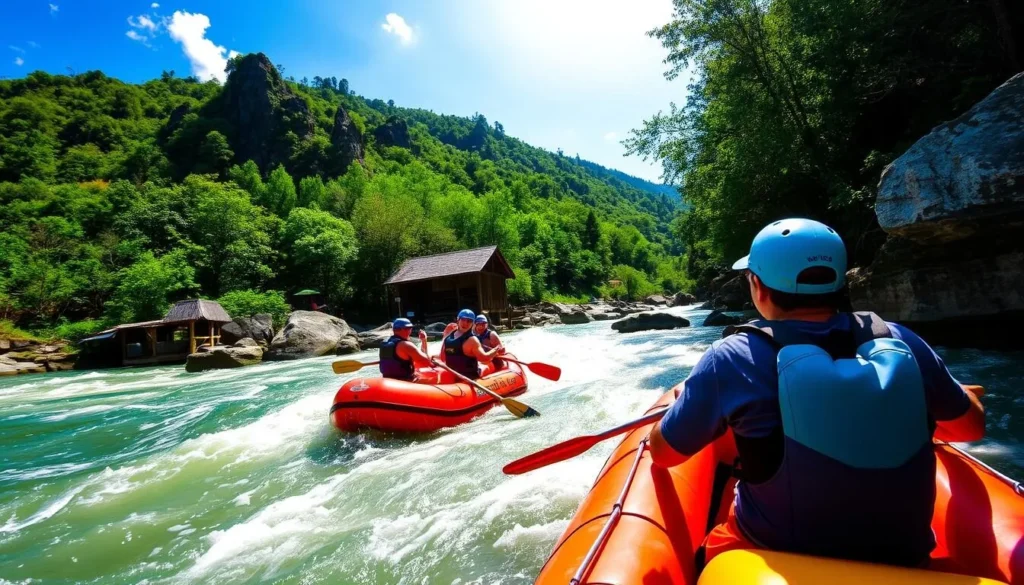
Cagayan de Oro, known as the Adventure Capital of Mindanao, is a must-visit destination for thrill-seekers. Located in Misamis Oriental in Northern Mindanao, Cagayan de Oro prides itself as “The Whitewater Rafting Capital of the Philippines.” The city offers a unique blend of adventure and natural beauty, making it an ideal spot for travelers looking for exciting experiences.
White Water Rafting on Cagayan River
Cagayan de Oro has earned its reputation as the “Adventure Capital of Mindanao” with its world-class white water rafting experiences on the Cagayan River. The rapids range from beginner-friendly Class I to challenging Class IV, ensuring that there’s something for every level of adventurer. Professional guides lead rafting tours that combine adrenaline-pumping adventure with stunning scenery as you navigate through 14 to 21 rapids, depending on your chosen course. The entire experience lasts 3-5 hours, making it a memorable day out.
Dahilayan Adventure Park: Asia’s Longest Dual Zipline
Just an hour’s drive from the city, Dahilayan Adventure Park in Bukidnon features Asia’s longest dual zipline at 840 meters. Here, you can soar at speeds up to 90 kph while taking in panoramic mountain views. The adventure park also offers additional activities, including a ropes course, ATV rides, and horseback riding, making it worth the day trip from Cagayan de Oro.
Urban Attractions and City Life
Within the city, visitors can explore Gaston Park, the St. Augustine Cathedral, and the Museum of Three Cultures, which showcases the region’s diverse heritage. Cagayan de Oro’s vibrant night markets and food parks offer a taste of local cuisine, with a particular emphasis on fresh seafood and regional specialties. The city serves as an excellent base for exploring Northern Mindanao, with easy connections to Camiguin Island, Bukidnon’s highlands, and the beaches of Misamis Oriental.
Camiguin: Island Born of Fire
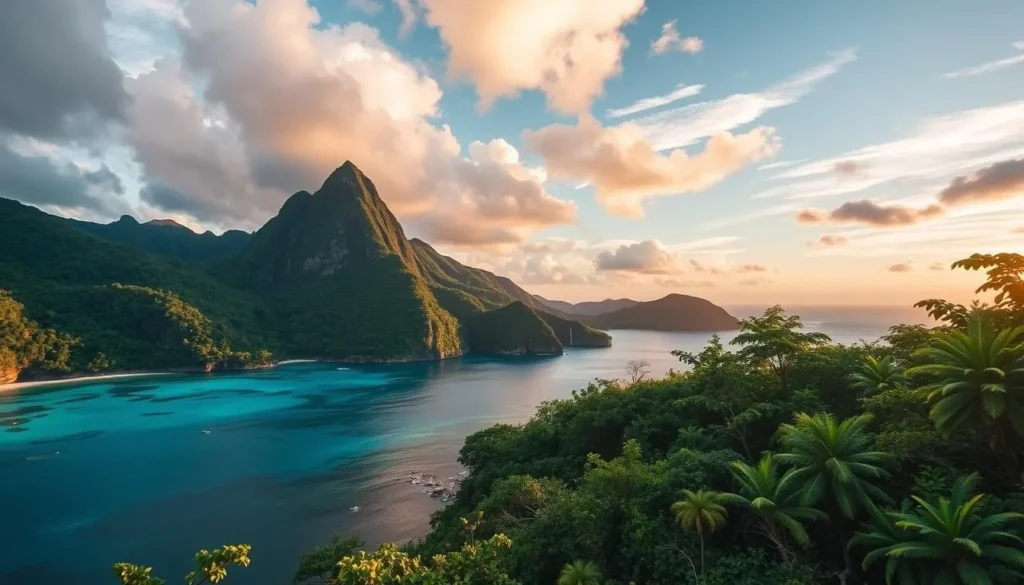
If you’re looking for a destination that’s off the beaten path, Camiguin Island is the perfect choice, offering a blend of natural wonders and cultural experiences. Known as the “Island Born of Fire,” Camiguin is home to seven volcanoes, with only one being active, creating a unique landscape of black sand beaches, hot springs, and lush forests.
White Island: Pristine Sandbar Paradise
One of Camiguin’s top attractions is White Island, a pristine white sand sandbar located just 1.4 km off the island’s northern shore. This idyllic destination offers stunning views of Mount Hibok-Hibok and crystal-clear waters perfect for swimming and snorkeling. The white sand beach is a must-visit, providing a relaxing atmosphere amidst the island’s natural beauty.
Sunken Cemetery: Unique Historical Site
The Sunken Cemetery is another iconic landmark on the island, marked by a large cross rising from the water. This haunting reminder of the 1871 volcanic eruption that submerged the original cemetery has become one of the Philippines’ most unique historical sites and a popular spot for snorkeling.
Hot and Cold Springs: Natural Relaxation
Camiguin’s volcanic activity has blessed the island with natural hot springs like Ardent Hot Springs, where temperatures reach up to 40°C, and refreshing cold springs like Sto. Niño Cold Spring. These natural wonders offer therapeutic relaxation, making them a perfect way to unwind after a day of exploring the island.
Hiking Mount Hibok-Hibok
For adventure seekers, hiking the active Mount Hibok-Hibok (1,332m) is a must-do. The challenging 3-4 hour trek is rewarded with panoramic views of the entire island and the surrounding Bohol Sea. This experience is a great way to appreciate the island’s rugged beauty and unique landscapes.
Camiguin’s compact size allows visitors to experience a diverse range of attractions in a short time, from waterfalls like Katibawasan Falls to heritage sites and beach relaxation. The island maintains an uncrowded, peaceful atmosphere, making it an ideal destination for those seeking a tranquil getaway.
Zamboanga City: Asia’s Latin City
In the southern Philippines, Zamboanga City stands out for its distinct Chavacano language and Latin-inspired culture. This unique blend of Spanish colonial heritage and local traditions earns it the nickname “Asia’s Latin City.” As you explore Zamboanga City, you’ll discover a rich history, vibrant culture, and breathtaking natural beauty.
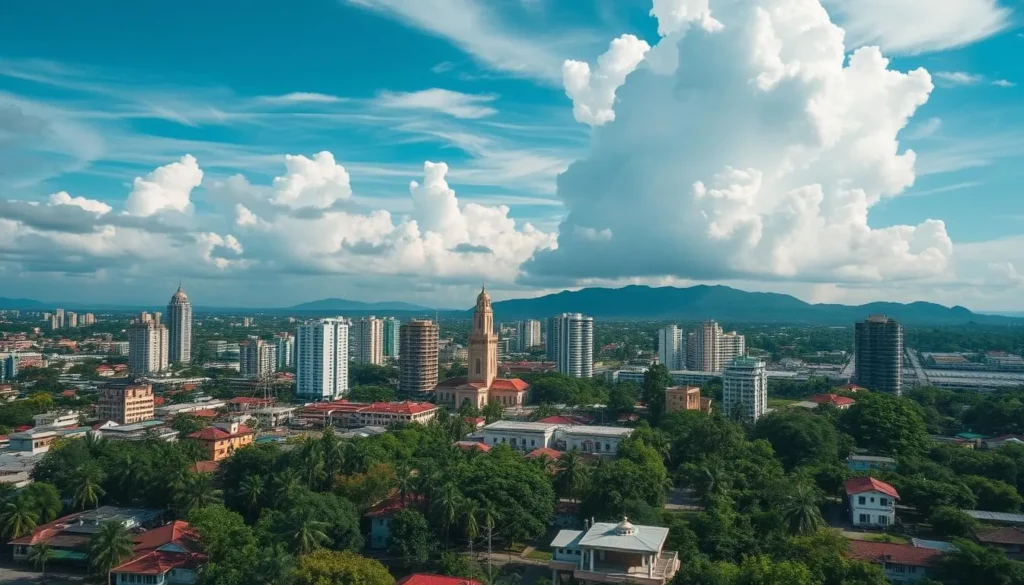
Pink Beach on Great Santa Cruz Island
One of the highlights of visiting Zamboanga City is a trip to Great Santa Cruz Island, famous for its stunning Pink Beach. The beach gets its unique color from crushed red organ pipe coral mixed with white sand, creating a breathtaking pink shoreline. This natural wonder is one of only a few pink beaches in the world, making it a must-visit destination.
Visits to Sta. Cruz Island are regulated to protect its delicate ecosystem. Day tours are available, which include boat transfers, swimming in crystal-clear waters, and exploring the island’s mangrove forest. This ensures that you can enjoy the beauty of the island while contributing to its conservation.
Fort Pilar and Historical Sites
Zamboanga City is home to numerous historical landmarks that reflect its rich cultural heritage. Fort Pilar, built in 1635 as a Spanish military defense fortress, is now an outdoor Catholic shrine and a national museum showcasing Zamboanga’s history and cultural artifacts. The fort is a testament to the city’s strategic importance during the Spanish colonial era.
The city’s colonial architecture is best observed along Calle R.T. Lim, where preserved Spanish-era buildings house government offices, shops, and restaurants. This historic street offers a glimpse into Zamboanga’s past, with its well-maintained buildings and charming atmosphere.
Vinta Sailing and Cultural Experiences
A traditional vinta sailing experience is a must-try when visiting Zamboanga City. These colorful sailboats with distinctive multi-colored sails have become an iconic symbol of Zamboanga culture. As you sail alongside mangroves and explore the city’s waterways, you’ll gain a deeper appreciation for the local culture and traditions.
Zamboanga City’s markets and food scene reflect its multicultural heritage, with specialties like Curacha (spanner crab), Satti (local satay), and Knicker Bocker (a unique dessert) that blend Malay, Spanish, and indigenous influences. Be sure to try these local delicacies to experience the full flavor of Zamboanga’s culture.
Enchanting Waters of Mindanao
Immerse yourself in the natural beauty of Mindanao’s enchanting waters, a true paradise for travelers. Mindanao, the southernmost major island in the Philippines, is home to a diverse array of breathtaking water attractions that promise an unforgettable experience.
Hinatuan Enchanted River: Mystical Blue Waters
The Hinatuan Enchanted River, also known as the Hinatuan Sacred River, is a mystical natural wonder that captivates visitors with its surreal sapphire and turquoise waters. Located in Surigao del Sur, this enchanting river is perfect for those seeking an otherworldly experience. To reach this captivating destination, fly to Surigao City or Butuan City, then take a bus or van to get to Hinatuan, the town closest to the river.
The river’s crystal-clear, azure waters invite you to swim and snorkel, and the underwater cave system adds to its mysterious charm. You can also witness the locals’ daily “feeding” of fish, making for a unique and memorable experience. Local legends claim the river is protected by supernatural guardians, adding to its allure.
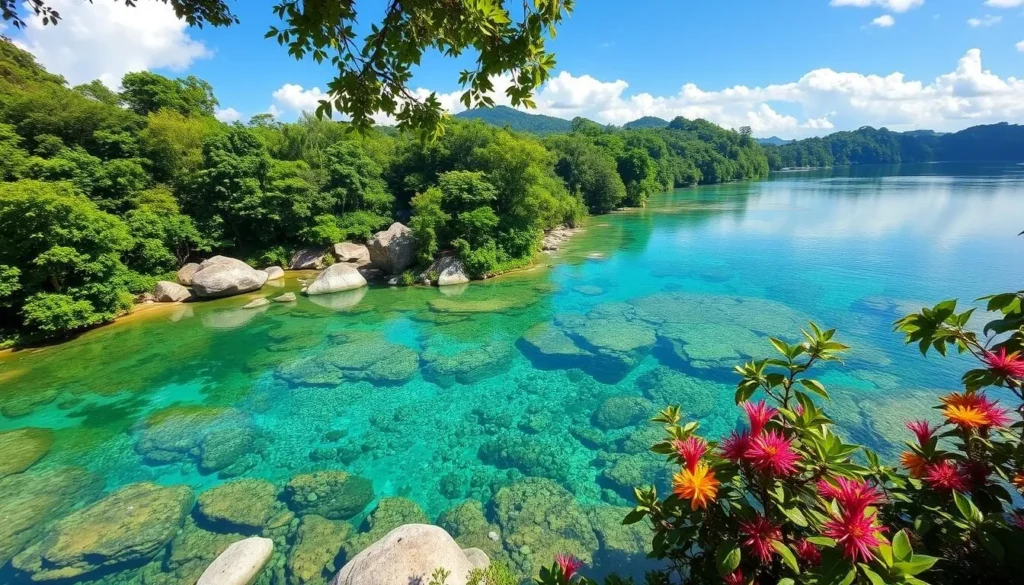
Tinuy-an Falls: The Niagara of the Philippines
Tinuy-an Falls in Bislig City earns its nickname as the “Niagara of the Philippines” with its impressive 55-meter wide, four-tiered white water curtain cascading through lush jungle. This breathtaking water attraction offers visitors the chance to swim in natural pools and witness rainbows forming in the mist on sunny mornings, creating a truly magical nature experience.
As you visit Tinuy-an Falls, you’ll be surrounded by the beauty of nature, making it an ideal spot for those looking to connect with the environment. The falls are a highlight of any tour to Mindanao, and the experience is sure to leave a lasting impression.
Lake Sebu: Seven Falls and Cultural Heritage
Lake Sebu in South Cotabato offers a complete nature and cultural experience, with its centerpiece being the Seven Falls – a series of magnificent waterfalls connected by the country’s highest zipline that allows visitors to soar above the forest canopy. The lake itself is home to the T’boli indigenous people, known as “Dreamweavers” for their intricate t’nalak cloth, making this destination as culturally rich as it is naturally beautiful.
Visitors can enjoy a tour of the area, taking in the breathtaking views and learning about the local culture. For those planning a trip to Mindanao, Lake Sebu is a must-visit destination that promises an unforgettable experience.
Organized tours to these water destinations often include transportation, guides, and sometimes meals, making them accessible even to those unfamiliar with Mindanao’s geography. The pristine condition of these water attractions highlights Mindanao’s less developed tourism industry, offering visitors experiences with nature that feel more authentic and less commercialized than in other parts of the Philippines.
Conquering Mount Apo: Philippines’ Highest Peak

As the highest peak in the Philippines, Mount Apo offers an exhilarating experience for climbers and a deep dive into the country’s rich nature. Located in Davao del Sur, this mountain is a must-visit destination for hikers and nature enthusiasts alike.
Hiking Routes and Difficulty Levels
Mount Apo is accessible through several hiking routes, each with its own level of difficulty. The Kidapawan trail, for instance, is considered the most challenging, while the Kapatagan trail in Davao del Sur is moderate. For less experienced climbers, the Tamayong trail offers a more accessible route.
The choice of trail depends on your hiking experience and physical condition. Regardless of the trail you choose, the climb typically takes 2-4 days, offering breathtaking views of the surrounding landscape.
Flora and Fauna of Mount Apo
The diverse ecosystems of Mount Apo support a wide range of flora and fauna. The mountain is home to over 272 bird species, including the critically endangered Philippine Eagle. The unique flora includes the Titan Arum, known as the world’s largest flower, and various orchid species found nowhere else.
As you ascend, you’ll witness dramatic changes in the landscape, from lush tropical forests to mossy cloud forests, and finally, to a volcanic boulder field near the summit.
Practical Tips for Climbers
Preparing for the climb involves more than just physical conditioning; it also requires the right gear and an understanding of the mountain’s cultural significance. Climbers should be prepared for varying temperatures, from hot and humid conditions at the base to near-freezing temperatures at the summit.
It’s also crucial to respect the indigenous communities who consider Mount Apo sacred. Hiring accredited guides and registering with the Department of Environment and Natural Resources is not only a safety measure but also a way to support conservation efforts.
Embarking on a trip to Mount Apo is a journey of a lifetime, offering an unforgettable experience in the heart of Davao del Sur. Whether you’re a seasoned hiker or just looking for a new adventure, Mount Apo awaits.
Beaches and Diving Spots in Mindanao
If you’re looking for a tropical paradise with pristine beaches and excellent diving opportunities, Mindanao is an ideal destination. The island boasts a diverse range of coastal areas that cater to different preferences, from relaxing on white sand beaches to exploring the underwater world.
Dahican Beach: Surfing and Marine Turtle Sanctuary
Dahican Beach in Mati, Davao Oriental, is a 7-kilometer stretch of pristine white sand beaches and crystal-clear blue waters that rival the more famous beaches of the Philippines but with fewer crowds. The crescent-shaped beach is known for both surfing and skimboarding, with consistent waves attracting enthusiasts year-round.
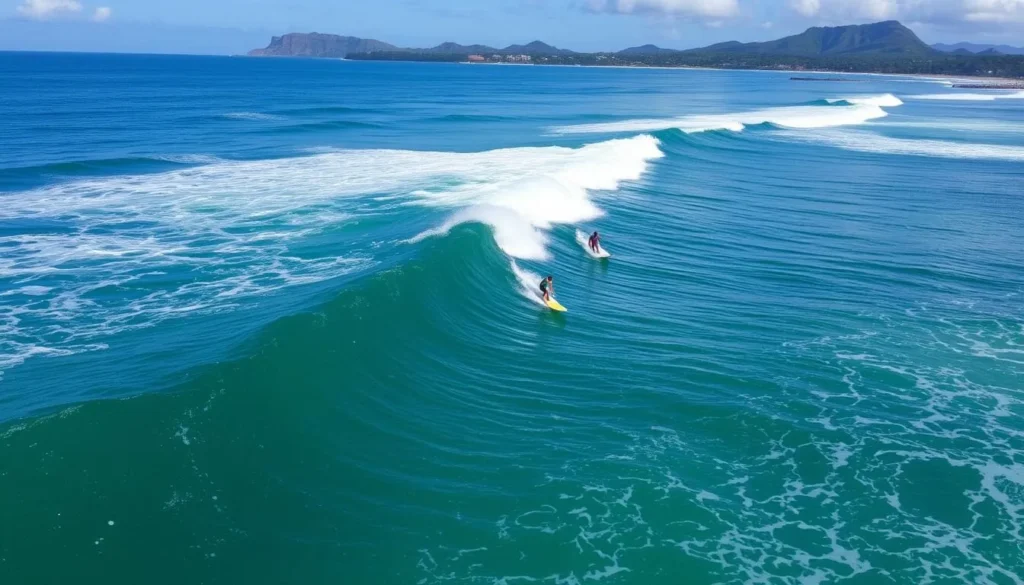
The beach also serves as a protected sanctuary for marine turtles that nest along its shores. Visitors can relax on the beach, swim in the crystal-clear waters, and watch the locals surf or skimboard, making it an ideal spot for a serene escape with natural beauty and a friendly, laid-back atmosphere.
Britania Group of Islands: Hidden Gems
The Britania Group of Islands in Surigao del Sur comprises 24 small islands and islets featuring white sand beaches surrounded by clear turquoise waters. These islands are accessible via island hopping tours from the mainland, offering a unique experience for visitors.
Highlights of the Britania island hopping experience include Hagonoy Island with its powdery white sand, Naked Island (a pure white sandbar with no vegetation), and Hiyor-Hiyoran Island with its unique rock formations and excellent snorkeling opportunities.
Diving in Sarangani Bay and Tubbataha Reefs
Sarangani Bay offers world-class diving with its vibrant coral gardens, diverse marine life including sea turtles and reef sharks, and excellent visibility year-round. This makes it a less crowded alternative to more popular Philippine diving destinations.
For serious divers, expeditions to Tubbataha Reefs Natural Park (accessible from Mindanao) provide access to one of the world’s premier diving destinations. This UNESCO World Heritage site is home to over 600 fish species, 360 coral species, and regular sightings of sharks, turtles, and manta rays.
Many of Mindanao’s beach destinations remain relatively undeveloped compared to those in Luzon and Visayas, offering more authentic experiences and often better value for accommodations and services. Whether you’re looking to relax on the beach, explore the underwater world, or simply enjoy the natural beauty of the island, Mindanao has something to offer for every kind of traveler.
Cultural Immersion in Mindanao
The cultural landscape of Mindanao is as diverse as it is vibrant, with 18 ethnolinguistic groups calling the island home. This diversity is reflected in the various cultural practices, traditions, and languages that have been preserved for centuries. As you journey through Mindanao, you’ll have the opportunity to experience the rich cultural heritage of the island firsthand.
Tribal Villages and Indigenous Communities
Mindanao offers unparalleled opportunities for cultural immersion, particularly in its tribal villages and indigenous communities. Visitors can experience authentic tribal village life through community-based tourism initiatives, where indigenous people share their daily activities, traditional knowledge, and cultural performances while benefiting directly from tourism. This not only provides a unique experience for travelers but also supports the local communities.
For instance, you can visit the T’boli people of South Cotabato, also known as “Dreamweavers,” who create the sacred t’nalak cloth using a complex process passed down through generations. The patterns on the t’nalak cloth are said to come to master weavers in their dreams, making each piece a true work of art.
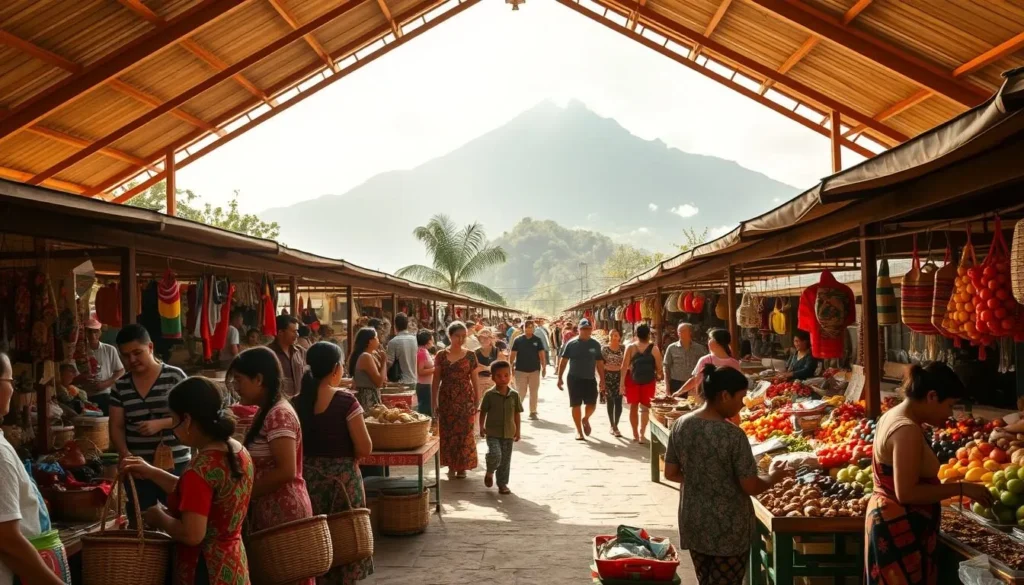
T’boli Handicrafts and Traditional Arts
Beyond textiles, indigenous arts flourish throughout Mindanao. From the intricate beadwork of the Bagobo Tagabawa to the brass casting of the Maranao people, many communities offer workshops where visitors can learn traditional crafting techniques. This hands-on experience allows travelers to appreciate the skill and craftsmanship that goes into creating these beautiful pieces.
| Craft | Community | Description |
|---|---|---|
| T’nalak weaving | T’boli | Sacred cloth woven with patterns received in dreams |
| Beadwork | Bagobo Tagabawa | Intricate designs using beads to create beautiful accessories |
| Brass casting | Maranao | Traditional metalwork creating decorative and functional items |
Muslim Heritage in Cotabato and Marawi
The Autonomous Region in Muslim Mindanao showcases the Philippines’ Islamic heritage through grand mosques like the Sultan Haji Hassanal Bolkiah Masjid in Cotabato City, also known as the Grand Mosque, the largest in the Philippines. Visitors can explore the rich history and culture of the region by visiting these significant landmarks and participating in a guided tour.
Cotabato City, in particular, is known for its rich cultural heritage and historical significance. You can reach Cotabato City by flying into the Awang Airport or taking a bus or private transportation from neighboring cities. The city’s vibrant markets, such as Tamontaka Market, offer a glimpse into the local way of life, while historical landmarks like Tantawan Park provide insight into the region’s complex history.
By embracing the local culture and respecting the customs and traditions of the communities you visit, you can have a meaningful and enriching experience in Mindanao. Whether you’re exploring the tribal villages, learning traditional crafts, or visiting significant Islamic landmarks, Mindanao offers a unique cultural immersion experience that will leave a lasting impression.
Mindanao Island, Philippines: Best Things to Do for Food Lovers
The island’s culinary identity is shaped by its indigenous, Malay, Spanish, and Middle Eastern influences, making it a fascinating destination for gastronomes. As you explore Mindanao, you’ll encounter a diverse array of flavors and dishes that reflect the region’s rich cultural heritage.
Must-Try Mindanaoan Delicacies
Mindanao’s culinary landscape is dotted with unique and mouth-watering delicacies that you shouldn’t miss. Some of the must-try dishes include Davao’s kinilaw, a refreshing raw fish dish marinated in coconut milk, and Zamboanga’s Curacha with Alavar sauce, a succulent spanner crab served with a secret recipe sauce. You should also try Tausug specialties like tiyula itum, a black soup made with beef or chicken, and satti, spicy skewered meat that’s perfect for barbecue enthusiasts.
Another dish that showcases the region’s culinary creativity is Sinuglaw, a fusion of grilled pork belly and kinilaw, offering a delightful mix of textures and flavors. These local specialties not only tantalize your taste buds but also provide a glimpse into the cultural diversity and traditions of Mindanao.
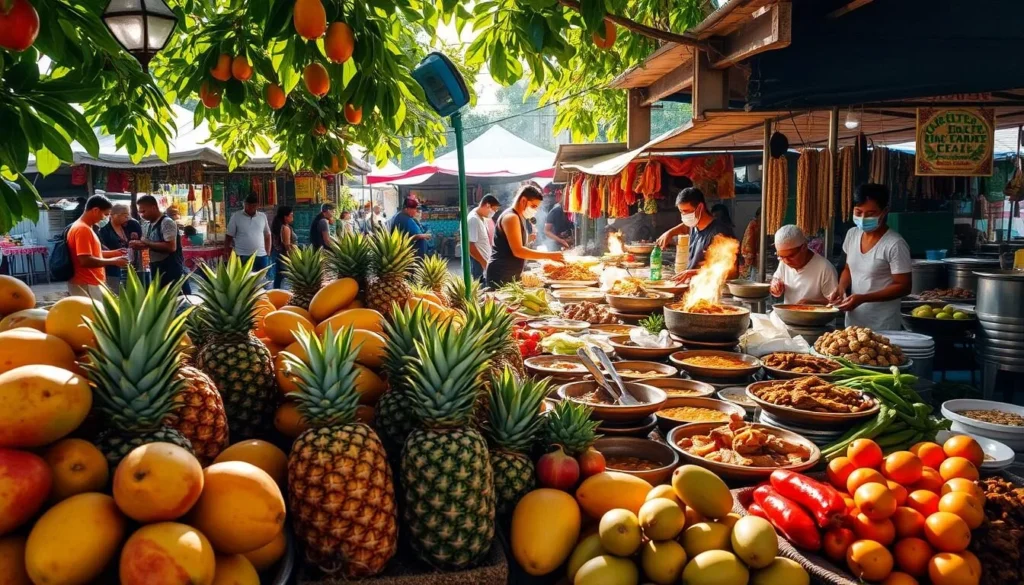
Seafood Experiences Along Coastal Areas
Mindanao’s extensive coastline offers an abundance of fresh seafood, making it a paradise for seafood lovers. Coastal cities like General Santos, known as the “Tuna Capital of the Philippines,” and Surigao provide exceptional seafood experiences. You can savor fish that’s so fresh it was swimming hours before reaching your plate at local restaurants.
Some of the top seafood experiences include dining at restaurants in General Santos that serve a variety of tuna dishes, from grilled to sinugba (tuna sashimi). You can also visit the Surigao fish markets to sample the day’s catch, often served raw or grilled to perfection.
| City | Seafood Specialty | Recommended Restaurant |
|---|---|---|
| General Santos | Tuna | The Fish Market |
| Surigao | Fresh Catch | Surigao Seafood Hub |
| Davao | Kinilaw | Davao Kinilaw House |
Durian and Exotic Fruits of Mindanao
Mindanao is renowned for its exotic fruits, particularly durian, the infamous “king of fruits.” Davao Region alone grows ten varieties of durian, alongside other tropical fruits like mangosteen, rambutan, lanzones, and the giant pomelo. The annual Durian Festival in Davao is a must-attend event for fruit enthusiasts, offering a chance to sample multiple durian varieties and durian-infused products.
In addition to durian, you can explore local markets and fruit stands to taste other exotic fruits. The region’s tropical climate and rich soil make it an ideal place for growing a wide range of fruits, ensuring a delightful experience for visitors.
To make the most of your food experience in Mindanao, consider joining a food tour that takes you through local markets, street food stalls, and family-owned restaurants. This will give you a deeper understanding of the local cuisine and its cultural significance.
Off-the-Beaten-Path Destinations in Mindanao
If you’re looking to venture off the beaten path, Mindanao has plenty of secrets to reveal, from pristine lakes to breathtaking waterfalls. This southern Philippine island is a treasure trove of natural wonders and unique cultural experiences waiting to be discovered.
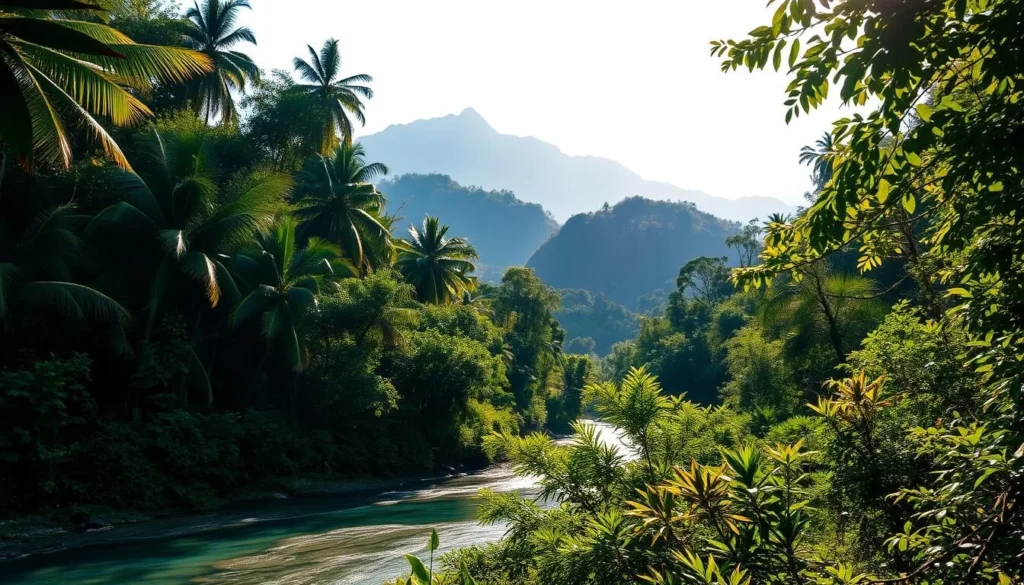
Lake Holon: Crater Lake Paradise
Lake Holon, nestled in the mountains of South Cotabato, is one of Mindanao’s most rewarding off-the-beaten-path experiences. The lake is surrounded by lush forests and rolling hills, creating a peaceful sanctuary. Visitors can camp overnight with permits, kayak on the calm waters, or simply disconnect from the world in this natural paradise.
The challenging 3-4 hour trek to the lake limits visitor numbers, preserving its pristine condition and making it an exclusive destination for those willing to venture off the beaten path.
Asik-Asik Falls: Curtain of Water
Asik-Asik Falls in North Cotabato presents a unique waterfall experience. Unlike traditional waterfalls, the water here seeps through rocks and vegetation, creating a 140-meter-wide curtain of water that appears to spring directly from the mountainside. This natural phenomenon is a breathtaking sight and a testament to Mindanao’s diverse nature.
The relatively recent discovery of Asik-Asik Falls and its remote location ensure smaller crowds, providing a more intimate nature experience compared to more famous Philippine waterfalls.
Agusan Marsh Wildlife Sanctuary
The Agusan Marsh Wildlife Sanctuary spans over 14,000 hectares of wetland ecosystem in northeastern Mindanao, serving as a crucial habitat for endangered species and migratory birds. Visitors can take a tour through the marsh, revealing a complex ecosystem of lakes, rivers, and swamps.
This sanctuary offers a glimpse into the floating village communities that have adapted to life on the water. Spotting Philippine crocodiles, flying foxes, and over 200 bird species is a thrilling experience that feels like a journey into a prehistoric landscape.
These remote destinations often require more planning and sometimes local guides, but they reward adventurous travelers with authentic experiences far from the tourist crowds found at more accessible attractions.
Practical Travel Tips for Exploring Mindanao
To make the most of your time in Mindanao, it’s essential to be prepared with the right travel tips. Mindanao, being the southernmost island group in the Philippines, offers a diverse range of experiences from vibrant city life to serene natural landscapes.
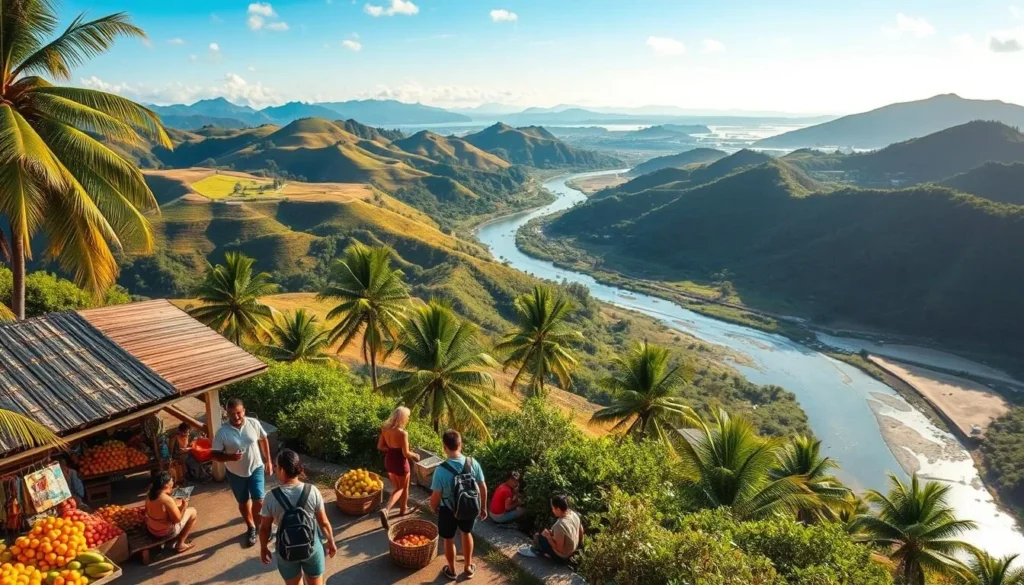
Getting Around: Transportation Options
Mindanao’s major cities, such as Davao, Cagayan de Oro, General Santos, and Zamboanga, are well-connected by regular flights from Manila and Cebu. Davao International Airport is the main gateway with the most frequent connections. Within these cities, you have various transportation options including jeepneys for the adventurous, tricycles for short distances, and taxis or ride-sharing apps like Grab in major urban areas.
For intercity travel, you can opt for comfortable air-conditioned buses that connect major destinations. Ferries are another option, linking coastal cities and providing access to beautiful islands like Camiguin and Siargao. Planning your trip requires attention to these schedules, which may change seasonally.
Accommodation Choices Across Mindanao
Mindanao offers a wide range of accommodations to suit different budgets. You can choose from budget hostels starting at $10/night, mid-range hotels ($30-60/night), to luxury resorts ($100+/night). The best values are often found in secondary destinations away from the main tourist hotspots, making your trip even more affordable.
Safety Considerations and Local Customs
While most of Mindanao’s popular tourist destinations are safe for visitors, it’s advisable to check current travel advisories for specific regions. This is particularly important for southwestern Mindanao, where security concerns may exist. Respect for local customs is also crucial, especially when visiting Muslim communities where conservative dress is appreciated.
During the holy month of Ramadan, it’s considerate to avoid public eating during daylight hours. Being mindful of these customs will enhance your tour experience and interactions with the locals.
Budgeting for Your Mindanao Adventure
Budget travelers can explore Mindanao comfortably on $30-40 per day. For those seeking more comfort and organized tours, planning for $60-100 per day is advisable. Costs in Mindanao are generally lower than in more touristy parts of the Philippines, making it an attractive destination for various types of travelers.
A valuable time-saving tip is to base yourself in hub cities like Davao or Cagayan de Oro and take day trips to nearby attractions. This approach allows you to maximize your exploration time without the hassle of constantly changing accommodations.
By planning your trip effectively, respecting local customs, and choosing the right transportation and accommodations, you can have a fulfilling and enjoyable tour of Mindanao.
Sustainable Tourism in Mindanao
The island of Mindanao is pioneering sustainable tourism practices that benefit both the environment and local communities. As a traveler, you have the power to contribute to this positive trend by making informed choices during your visit.
Eco-Friendly Initiatives and Responsible Travel
Mindanao is at the forefront of sustainable tourism in the Philippines, with many communities developing eco-friendly initiatives that protect the island’s rich biodiversity while providing economic opportunities for local people. For instance, several destinations implement strict visitor caps to prevent over-tourism. Places like Siargao’s Sugba Lagoon, the Enchanted River, and Mount Apo have limited visitor numbers, ensuring these natural wonders aren’t overwhelmed by tourism despite their growing popularity.
Responsible tour operators play a crucial role in sustainable tourism. They prioritize employing local guides, using locally-owned accommodations, and ensuring fair compensation for communities involved in tourism activities. This approach creates a more equitable distribution of tourism revenue, benefiting the local economy and fostering a deeper connection between visitors and the island’s culture.
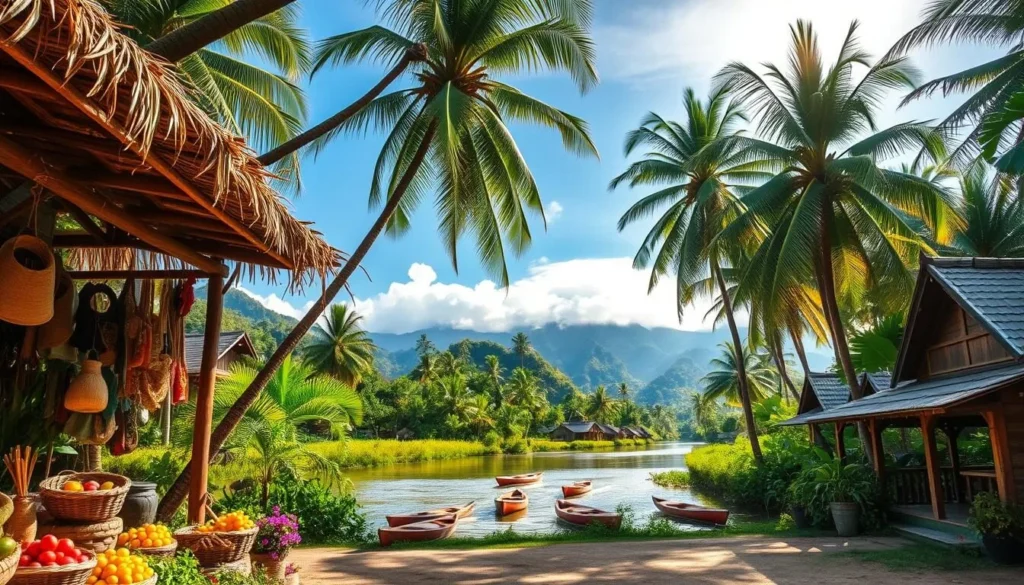
Supporting Local Communities
Community-based tourism initiatives are thriving throughout Mindanao. Programs like the Lake Sebu School of Living Traditions and the Tboli Cultural Village allow indigenous people to share their heritage on their own terms while receiving direct economic benefits. By participating in these community-led tours, you can gain a deeper understanding of the local culture and contribute to the preservation of traditional practices.
When you choose to stay in locally-owned accommodations and dine at family-run restaurants, you’re directly supporting the local economy. This not only enhances your travel experience but also helps to distribute the economic benefits of tourism more evenly across the community.
| Community Initiative | Location | Benefits |
|---|---|---|
| Lake Sebu School of Living Traditions | Lake Sebu, South Cotabato | Preserves indigenous culture, provides education and economic opportunities |
| Tboli Cultural Village | Lake Sebu, South Cotabato | Showcases Tboli heritage, supports local artisans |
| Siargao Island Tour | Siargao Island, Surigao del Norte | Promotes eco-tourism, supports local guides and businesses |
Conservation Efforts and Wildlife Protection
Conservation efforts in Mindanao focus on protecting the island’s incredible biodiversity, including the critically endangered Philippine Eagle. Sanctuaries and breeding programs work tirelessly to preserve species found nowhere else on Earth. As a visitor, you can contribute to these conservation efforts by choosing tour operators with strong environmental policies and participating in activities like beach clean-ups and tree-planting.
It’s also crucial to respect wildlife by maintaining appropriate distances and never purchasing products made from endangered species. By making these conscious choices, you help ensure that Mindanao’s natural beauty and wildlife continue to thrive for generations to come.
Sustainable tourism is not just a trend; it’s a necessity for preserving the authentic cultural experiences and pristine natural environments that make Mindanao special. By choosing eco-friendly accommodations, supporting local communities, and respecting the island’s nature, you can have a positive impact on this beautiful island and its people.
Conclusion: Why Mindanao Should Be Your Next Philippine Adventure
Nestled in the southern Philippines, Mindanao is a captivating island that promises an unforgettable travel experience. As you’ve discovered through this article, Mindanao offers a diverse array of attractions and activities that cater to all kinds of travelers.
One of the standout features of Mindanao is its pristine beaches, majestic waterfalls, and volcanic landscapes, which provide a serene and unspoiled environment for visitors. The island’s cultural diversity is another significant draw, with opportunities to explore indigenous villages, experience Spanish colonial influences, and engage with vibrant Muslim communities.
For adventure seekers, Mindanao is a paradise. Whether you’re surfing world-class waves in Siargao, conquering the country’s highest peak at Mount Apo, or navigating white water rapids in Cagayan de Oro, there’s no shortage of thrilling experiences. Meanwhile, food enthusiasts can embark on a culinary journey through Mindanao’s regional cuisines, sampling exotic fruits, fresh seafood, and dishes influenced by centuries of cultural exchange.
The value proposition for travelers is exceptional, with accommodations, food, and activities generally costing less than in more established tourist destinations. This affordability, combined with the high quality and personalized nature of the experiences, makes Mindanao an attractive choice.
Mindanao’s tourism industry is at an exciting stage of development, where infrastructure has improved enough to make travel comfortable while destinations retain their authenticity and natural beauty. This balance makes it an ideal time to visit Mindanao, before it becomes too popular and loses its charm.
By choosing Mindanao for your next Philippine adventure, you’ll not only create unforgettable memories but also contribute to sustainable tourism development that benefits local communities while preserving the natural and cultural treasures that make this island truly special.
The time to visit Mindanao is now, as it offers everything from world-class beaches and diving to cultural immersion and mountain adventures in one diverse destination. With its unique blend of natural beauty, cultural richness, and adventure opportunities, Mindanao is poised to become your next favorite travel destination.
